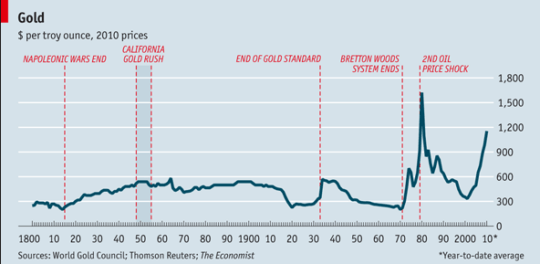The warring forces of inflation and deflation are at each other’s throats. Some see victory for inflation. Others for deflation.
So… What happens to gold?
Conventional wisdom says gold thrives under inflation and wilts under deflation. The case for gold under inflation is easy enough. Gold rises as the dollar falls. It’s the opposite under deflation.
But is conventional wisdom right about gold and deflation? Is it time to consider a different metric — not the nominal gold price — but gold’s purchasing power relative to consumer prices?
The late lamented Roy Jastram was a recognized authority on the gold standard. He authored a 1977 tour de force on gold under both deflation and inflation called The Golden Constant: The English and American Experience, 1560–1976.
Jastram went over the rainbow in 1991 but his book’s withstood time and tide.
Jastram examined three deflationary periods in history. The first was from 1814–30. The record shows prices fell 50% over those 16 years.
The second was from 1864–97. Prices fell 65% between 1864 and 1897.
The final deflationary period was 1929–33, the locust years of the Great Depression. Prices slumped 31% those four years.
So… How did gold do in these three deflationary periods stretching back 200 years?
First, the period between 1814 and 1830…
Prices fell 50%. But according to Jastram, gold’s purchasing power — not its nominal price but its purchasing power — increased a thumping 100%. Gold bought twice as much!
The chart below shows the nominal gold price rose over that period. But not nearly as much as its overall purchasing power.
What about the era between 1864 and 1897? Overall prices fell 65%. But Jastram claimed gold’s purchasing power surged 40%.
The chart shows the nominal gold price held fairly constant between 1864 and 1897. But again, gold’s purchasing power rose 40%.
Note well: This period encompassed the classical gold standard, 1870–1914. It also witnessed one of the greatest spurts of economic growth in history. Who says gold kills growth?
Finally, 1929–33…
Here’s the chart of gold prices 1800–2010:

In nuce: It doesn’t matter if gold falls if overall prices fall further — so gold is precious, even under deflation. Jim Rickards, in The New Case for Gold:
Assume
gold is $1,200 at the start of a year and there is 5% deflation that
year. Further assume that the dollar price of gold at the end of the
year is $1,180. In that scenario, the nominal price of gold fell 1.7% but the real price of gold rose about 3.3%,
because the $1,180 year-end dollar price is actually worth $1,240 in
purchasing power relative to prices at the beginning of the year.
Now, it’s true… history can kick up plenty of dust, potentially making comparisons between erasa fool’s chase.For example, the price of gold was fixed at $20.67 under the classical gold standard between 1870 and 1914. It remained $20.67 in the U.S. through 1934 when FDR devalued gold to $35 an ounce. That makes it harder to penetrate the cloud.
But as analyst Doug Eberhardt notes, maybe the gold price — and hence its purchasing power — may have surged even higher if gold traded at freely floating prices. From 1929–33 for example:
If
people were rushing to the bank to demand gold coin for their Federal
Reserve notes, the price of gold would have naturally moved higher. I
don’t think anyone doubts that this would have occurred. Banks were
failing at an alarming rate and people were running to the real wealth
represented by gold.
Maybe gold would have vaulted much higher if it weren’t pegged at $20.67.Jastram croaked before the 2008 crisis so on that score his book stands silent. But looking at the consumer price index (CPI) since 2009 we find a pattern of chronically low inflation. It’s averaged about 1.8%.
The CPI is a government tool, so your personal experience will vary with usage. But take it on its face for now.
Gold ended 2009 at $1,096 an ounce. It trades at $1,227 today… $131 higher. Yes, that includes a roughly $500 drop between 2012 and 2016. But the course of true love never runs true. Neither do long-term economic trends.
But if you measure gold not by its nominal price but by its purchasing power… history suggests deflation might not be so bad for gold after all.
Regards,
Brian Maher
No comments:
Post a Comment